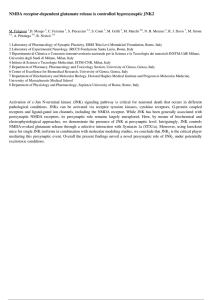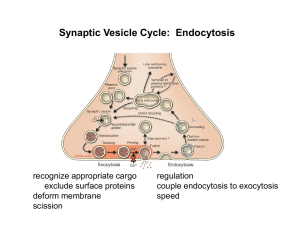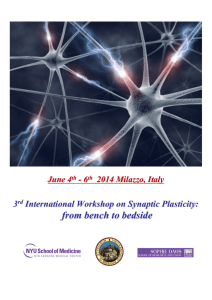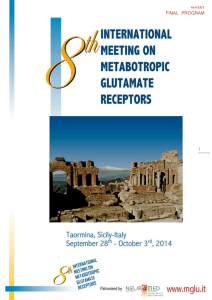CV Tiziana Borsello: Anatomia, Ricerca Neurodegenerazione
advertisement
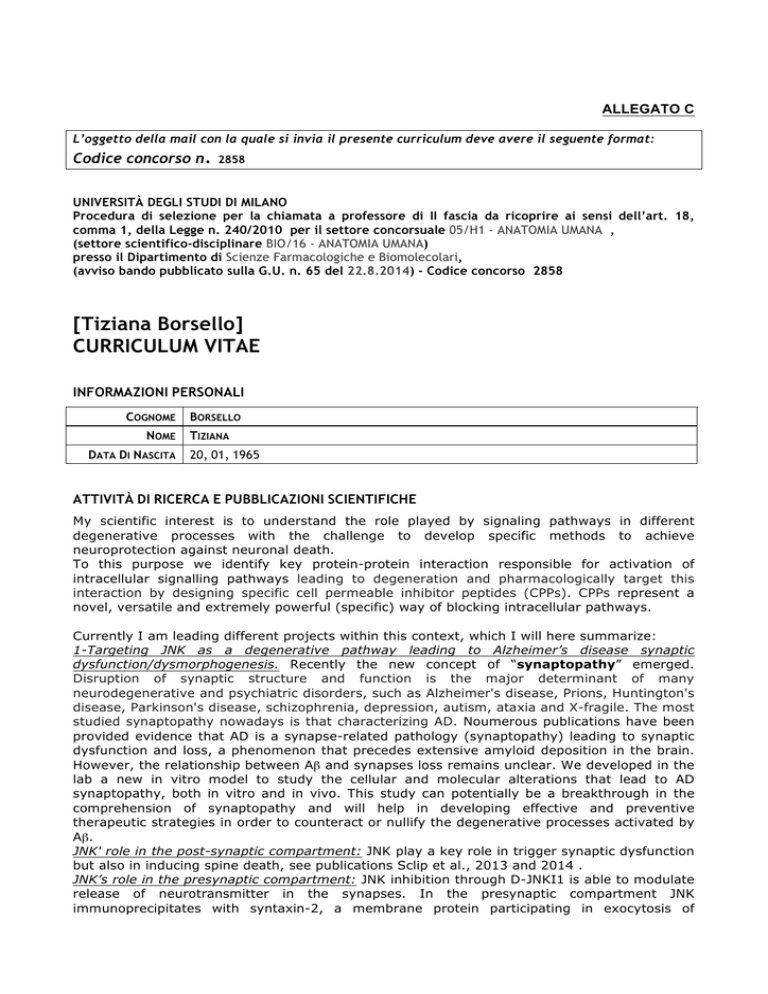
ALLEGATO C L’oggetto della mail con la quale si invia il presente curriculum deve avere il seguente format: Codice concorso n. 2858 UNIVERSITÀ DEGLI STUDI DI MILANO Procedura di selezione per la chiamata a professore di II fascia da ricoprire ai sensi dell’art. 18, comma 1, della Legge n. 240/2010 per il settore concorsuale 05/H1 - ANATOMIA UMANA , (settore scientifico-disciplinare BIO/16 - ANATOMIA UMANA) presso il Dipartimento di Scienze Farmacologiche e Biomolecolari, (avviso bando pubblicato sulla G.U. n. 65 del 22.8.2014) - Codice concorso 2858 [Tiziana Borsello] CURRICULUM VITAE INFORMAZIONI PERSONALI COGNOME NOME DATA DI NASCITA BORSELLO TIZIANA 20, 01, 1965 ATTIVITÀ DI RICERCA E PUBBLICAZIONI SCIENTIFICHE My scientific interest is to understand the role played by signaling pathways in different degenerative processes with the challenge to develop specific methods to achieve neuroprotection against neuronal death. To this purpose we identify key protein-protein interaction responsible for activation of intracellular signalling pathways leading to degeneration and pharmacologically target this interaction by designing specific cell permeable inhibitor peptides (CPPs). CPPs represent a novel, versatile and extremely powerful (specific) way of blocking intracellular pathways. Currently I am leading different projects within this context, which I will here summarize: 1-Targeting JNK as a degenerative pathway leading to Alzheimer’s disease synaptic dysfunction/dysmorphogenesis. Recently the new concept of “synaptopathy” emerged. Disruption of synaptic structure and function is the major determinant of many neurodegenerative and psychiatric disorders, such as Alzheimer's disease, Prions, Huntington's disease, Parkinson's disease, schizophrenia, depression, autism, ataxia and X-fragile. The most studied synaptopathy nowadays is that characterizing AD. Noumerous publications have been provided evidence that AD is a synapse-related pathology (synaptopathy) leading to synaptic dysfunction and loss, a phenomenon that precedes extensive amyloid deposition in the brain. However, the relationship between Aβ and synapses loss remains unclear. We developed in the lab a new in vitro model to study the cellular and molecular alterations that lead to AD synaptopathy, both in vitro and in vivo. This study can potentially be a breakthrough in the comprehension of synaptopathy and will help in developing effective and preventive therapeutic strategies in order to counteract or nullify the degenerative processes activated by Aβ. JNK' role in the post-synaptic compartment: JNK play a key role in trigger synaptic dysfunction but also in inducing spine death, see publications Sclip et al., 2013 and 2014 . JNK’s role in the presynaptic compartment: JNK inhibition through D-JNKI1 is able to modulate release of neurotransmitter in the synapses. In the presynaptic compartment JNK immunoprecipitates with syntaxin-2, a membrane protein participating in exocytosis of presynaptic vesicles. JNK binding to syntaxin2 is inhibited by D-JNKI1 (a potent JNK inhibitor), suggesting that this interaction is involved in the regulation of glutamate release. These results allow to better understand the mechanisms regulating synaptic plasticity and set the basis for the development of new molecules able to modulate the release of glutamate. 2-Characterize a new mutation on APP aiming at developing AD therapies. We characterized a new mutation on the APP gene (A673V) which was recently discovered by Prof. Tagliavini group ref. The same group described that this mutation causes pathology only in homozygosity, while heterozygous subjects don’t show any AD-related symptoms. It has thus been hypothesized that Ab wt and mut mix has a neuroprotective effect. This hypothesis lead us to generate a new cell-permeable peptide (D-TAT 1-6 A2V) based on the APP mutated region. The peptide showed no toxicity in vitro, and if used in combination with WT Aβ prevented from glutamate receptors, PSD proteins and dendritic spines loss induced by Aβ. We confirmed this data also in a preliminary in vivo experiment on a murine model of AD. The treatment had no toxic effects on the animals and reverted amyloid-induced dendritic spines loss, increasing PSD marker levels at the postsynaptic compartments. These results are encouraging and set the basis for a promising strategy to prevent AD progression even in the early stages of synaptopathy. 3-Study the role of JNK pathway in Rett syndrome. Rett syndrome (RTT) is a progressive neurodevelopmental disorder and one of the most common causes of mental retardation in females. RTT is caused by heterozygous mutations in the X-linked MECP2 gene, encoding methyl-CpG-binding protein-2, a transcription factor. Studies in RTT mice established MeCP2 as a critical mediator of synaptic scaling and raised the possibility that some of the neurological defects of Rett syndrome arise from disruption of homeostatic plasticity. Our data suggests that JNK is a key player in the regulation of synaptic plasticity and dysfunction. We have thus being studying JNK as a possible mediator of synaptic dysfunction in animal model of Rett syndrome. We have been using different Mecp2 mouse models: 1) Mecp+/- , heterozygous mutation found in RTT females as well 2) Mecp2 Knockout, where the gene is completely knockout in order to study its role in synaptopathy. We found that JNK pathway is activated in these models. We are currently testing the effect of D-JNKI1 treatment on RTT, and analysing behaviour as well as biochemical and structural changes at the synaptic level in both saline and D-JNKI1 treated mice. 4-Search for new biomarkers in the CSF of MCI & AD. The cerebrospinal fluid (CSF) is suitable for identification of new AD markers since it is in direct contact with the brain and therefore is able to reflect, better than any other biological fluid, the different structural and biochemical changes that occur in the brain. In my laboratory we have shown that exposure to Aß oligomers strongly activates the JNK kinase at the synaptic level (Sclip et al. 2011) and that this activation precedes any structural and biochemical changes we observed at synapses. This discovery led us to think that JNK could be a new pre-symptomatic non-amyloidogenic marker of great interest for the early and differential diagnosis of AD. We analyzed 15 samples of CSF from subjects not affected (NA), subjects with mild cognitive impairment (MCI), considered one of the major risk factors for AD, and subjects with AD, in order to test whether there was trace of total JNK and phosphorylated JNK in the CSF, and if these levels were different in the clinical categories. From the preliminary analysis we found a statistically significant ratio increase in pJNK/JNK in MCI subset and similar levels in healthy controls, in the second MCI sub-group and in AD group. A similar variability can be explained by the fact that the MCI stadium can not be considered as a homogeneous condition, but as a true syndrome that includes subgroups of disease for different etiology, pathogenesis and natural history, all united by a common final pathway or by a mild cognitive disorder. This data are really encouraging and we are currently expanding the sample size to verify the presence of correlations between JNK levels in the CSF and early stages of AD. 5-Design and synthesis of new cell permeable inhibitor peptides targeting MKK7. Based on MKK7 and Gadd45 interaction we design and synthesized two new CPPs: Gadd45 (69-86) containing the MKK7 binding region only and Gadd45 (60-86) that contains the MKK7 docking region as well as a region that is essential for MKK7 inactivation. Preliminary studies in an animal model of cerebral ischemia treated with the MKK7I peptide 30 minutes before the damage, have shown an encouraging reduction of the infarct size, equivalent to 50% compared to controls. We are now testing the neuroprotective peptide in different ischemic models and we will analyze the therapeutically temporal windows after ischemia. Publications: web of science search: Results found: 54 Sum of times cited without self-citation: 1585 h-index: 20 Paper first name: 9 Paper last name: 22 Book: Editor of the volume Neuroprotection: Methods in Molecular Biology published by Humana Press, USA (http://humanapress.com). Middle 2007. Papers: Tozzi A, Sclip A, Tantucci M, de Iure A, Ghiglieri V, Costa C, Di Filippo M, Borsello T, Calabresi P. Region- and age-dependent reductions of hippocampal long-term potentiation and NMDA to AMPA ratio in a genetic model of Alzheimer's disease. Neurobiol Aging. 2014 Jul 10. IF 5.127 Davoli E, Sclip A, Cecchi M, Cimini S, Carrà A, Salmona M, Borsello T. Determination of tissue levels of a neuroprotectant drug. the cell permeable JNK inhibitor peptide. J Pharmacol Toxicol Methods. 2014 May 9;70(1):55-61. IF 2.15 Sclip A, Tozzi A, Abaza A, Cardinetti D, Colombo I, Calabresi P, Salmona M, Welker E, Borsello T. c-Jun N-terminal kinase has a key role in Alzheimer disease synaptic dysfunction in vivo. Cell Death Dis. 2014 Jan 23;5. IF 6.044 Sclip A, Arnaboldi A, Colombo I, Veglianese P, Colombo L, Messa M, Mancini S, Cimini S, Morelli F, Antoniou X, Welker E, Salmona M, Borsello T. Soluble Aβ oligomer-induced synaptopathy: cJun N-terminal kinase's role. J Mol Cell Biol. 2013 Aug;5(4). IF 7.308 Fluharty BR, Biasini E, Stravalaci M, Sclip A, Diomede L, Balducci C, La Vitola P, Messa M, Colombo L, Forloni G, Borsello T, Gobbi M, Harris DA. An N-terminal fragment of the prion protein binds to amyloid-β oligomers and inhibits their neurotoxicity in vivo. J Biol Chem. 2013 Mar 15;288 (11). IF 4.651 Forloni G, Sclip A, Borsello T, Balducci C. The neurodegeneration in Alzheimer disease and the prion protein. Prion. 2013 Jan 1;7(1). IF 2.133 Esposito S, Pristerà A, Maresca G, Cavallaro S, Felsani A, Florenzano F, Manni L, Ciotti MT, Pollegioni L, Borsello T, Canu N. Contribution of Serine racemaseD-serine pathway to neuronal apoptosis Aging Cell. 2012 Apr 16. IF 5.705 Repici M, Chen X, Morel MP, Doulazmi M, Sclip A, Cannaya V, Veglianese P, Kraftsik R, Mariani J, Borsello T, Dusart I. Specific inhibition of the JNK signalling pathway promotes locomotor recovery and neuroprotection after mouse spinal cord injury Neurobiol Dis. 2012 Jun;46(3):710-21. IF 5.624 Antoniou X, Borsello T. The JNK signalling transduction pathway in the brain Front Biosci (Elite Ed). 2012 Jan 1;4:2110-20. IF 0 Feligioni M, Brambilla E, Camassa A, Sclip A, Arnabold Ai, Morelli F, Antoniou X, Borsello T. Crosstalk between JNK and SUMO signaling pathway: deSUMOylation is protective against HOinduced cell death. PLoS ONE 2011 Dec. 2. IF 4,092 Sclip A, Antoniou X, Colombo A, Camici GG, Pozzi L, Cardinetti D, Feligioni M, Veglianese P, Bahlmann FH, Cervo L, Balducci C, Costa C, Tozzi A, Calabresi P, Forloni G, Borsello T. c-Jun N-terminal Kinase regulates soluble Abeta oligomers and cognitive impairment in an AD mouse model. J. Biol. Chem. 2011 Oct 27. IF 5.38 Antoniou X, Falconi M, Di Marino D, Borsello T. JNK3 as a Therapeutic Target for Neurodegenerative Diseases. J Alzheimers Dis. 2011 Jan;24(4):633-42. IF 4.745 Ploia C, Antoniou X, Sclip A, Grande V, Cardinetti D, Colombo A, Canu N, Benussi L, Ghidoni R, Forloni G, Borsello T. JNK Plays a Key Role in Tau Hyperphosphorylation in Alzheimer's Disease Models. J Alzheimers Dis. 2011. IF 3.745 Repici M, Wehrlé R, Antoniou X, Borsello T, Dusart I. C-Jun N-Terminal Kinase (JNK) And P38 Play Different Roles In Age-Related Purkinje Cell Death In Murine Organotypic Culture. Cerebellum 2011; 10(2):281-90. IF 3.207 Urru S., Velgianese P., De Luigi A., Fumagalli E., Erba E., Gonella Diaza R., Carrà A., Davoli E., Borsello T, Forloni G, Pengo N., Cascio P., Cenci S., Sitia R., Salmona M. A New Fluorogenic Peptide Determines Proteasome Activity In Single Cells. J Med Chem. 2010 Oct 28;53(20):7452-60. IF 5.207 Epis R, Marcello E, Gardoni F, Vastagh C, Malinverno M, Balducci C, Colombo A, Borroni B, Vara H, Dell'agli M, Cattabeni F, Borsello T, Giustetto M, Forloni G, Padovani A, Di Luca M. Blocking ADAM10 Synaptic Trafficking Generates A Model Of Sporadic Alzheimer's Disease. Brain. 2010 Nov;133(11):3323-35. IF 9.23 Balducci C, Begg M, Stravalaci M, Bastone A, Sclip A, Biasini E, Tapella L, Colombo L, Manzoni C, Borsello T, Chiesa R, Gobbi M, Salmona M, Forloni G. PNAS Feb 2;107(5):2295-300Synthetic Amyloid-Beta Oligomers Impair Long-Term Memory Independently Of Cellular Prion Protein (2010). IF 9.771 Ploia C, Sclip A, Colombo A, Repici M, Gardoni F, Di Luca MG, Forloni G, Antoniou X, Borsello T. Role Of Glycogen Synthase Kinase-3Beta In App Hyperphosphorylation Induced By Nmda Stimulation In Cortical Neurons (2010). Www.mdpi.com/journal/pharmaceuticals, January 2010 Pharmaceticals 3(1), 42-58. IF 0 Antoniou X, Sclip A, Ploia C, Colombo A, Moroy G, Borsello T. JNK Contributes To Hif-1Αlfa Regulation In Hypoxic Neurons (2010) Mdpi.com/journal/molecules Molecules 2010, 15(1), 114-127. IF 1.988 Ortolano F, Colombo A, Zanier ER, Sclip A, Longhi L, Perego C, Stocchetti N, Borsello T, De Simoni MG. c-Jun N-terminal kinase pathway activation in human and experimental cerebral contusion (2009) J Neuropathol Exp Neurol. 2009 Sep;68 (9):964-71. IF 4.564 Colombo A, Bastone A, Ploia C, Sclip A, Salmona M, Forloni G, Borsello T. JNK regulates APP cleavage and degeneration in a model of Alzheimer disease (2009) Neurobiol Dis. 2009 Mar;33(3):518-25. IF 4.518 Lehnert M., Relja B., Sun Young Leee V., Schwestka B., Henrich D., Czerny C., Froh M., Borsello T., Marzi I.A peptide inhibitor of c-jun N-terminal kinase modulates hepatic damage and the inflammatory response after hemorrhagic shock and resuscitation. (2009) Shock. 2009 Aug;30(2):159-165. IF 2.732 Repici M., Mare L., Colombo A., Ploia C., Sclip A., Bonny C., Nicod P., Salmona M. and Borsello T. c-jun N-terminal Kinase- binding domain (JBD)-dependent phosphorylation of MKK4 and MKK7 and balancing cross-talk between JNK and ERK pathways in cortical neurons. (2008) Neuroscience 2009 Mar 3;159(1):94-103. IF 3.292 Repici M, Zanjani HS, Gautheron V, Borsello T, Dusart I and Mariani J. Specific JNK inhibition by D-JNKI1 protects Purkinje cells from cell death in Lurcher mutant mouse. (2008) Cerebellum. 2008;7(4):534-8. IF 3.847 Gianluigi F., Colombo A. , T. Borsello. Phosphopylation of APP, TAU and PIN1 is regulated by JNK (2008) Alzheimers & Dementia - ALZHEIMERS DEMENT.P1-428 01/2008; 4(4). IF 14.48. Lehnert M, Relja B, Sun-Young Lee V, Schwestka B, Henrich D, Czerny C, Froh M, Borsello T, Marzi I. A peptide inhibitor of c-Jun N.termnal kinase modulates hepatic damage and the inflammatory response after hemorragic shock and resuscitation. Shock. 2008 Aug;30(2):15965. IF 2.732 Repici M., Mariani J. and Borsello T. Neuronal death and neuroprotection: a review. (2007) Methods Mol Biol. 2007;399:1-14. Review. Bigini P., Repici M., Cantarella G. Fumagalli E., Barbera S., Cagnotto A., De Luigi A., Tonelli R., Bernardi R. , Borsello T., Mennini T. Recombinant human TNF-binding protein-1 (rhTBP-1) treatment delays both symptoms progression and motor neuron loss in the wobbler mouse. (2007) Neurobiol Dis. 2007 Nov 12. IF 4.852 Repici M, Centeno C, Tomasi S, Forloni G, Bonny C, Vercelli A, Borsello T. Time-Course Of C-Jun N-Terminal Kinase Activation After Cerebral Ischemia And Effect Of D-Jnki1 On C-Jun And Caspase-3 Activation. (2007) Neuroscience. 2007 Nov 30;150(1):40-9. IF 3.292 Borsello T., Centeno C., Riederer IM, Haeflinger JA and Riedere BM.Phosphorylation-dependent dimerization and subcellular localization of islet-brain 1/c-Jun N-terminal kinase-interacting protein 1. (2007) J Neurosci Res. 2007 Dec;85(16):3632-41. IF 2.729 Colombo A, Repici M, Pesaresi M, Santambrogio S, Forloni G, Borsello T. The Tat-Jnk Inhibitor Peptide Interferes With Beta Amyloid Protein Stability (2007) Cell Death Differ. 2007 Oct;14(10):1845-8. IF 8.254 Borsello T. and Forloni G. JNK signalling: a possible target to prevent neurodegeneration. (2007) Current Pharmaceutical Design 2007, 13, 1875-1886. IF 4.868 Vaslin A, Puyal J, Borsello T, Clarke PG. Excitotoxicity-related endocytosis in cortical neurons (2007) J Neurochem. 2007 Aug;102(3):789-800. Epub 2007 Apr 16. IF 4.244 Centeno C, Repici M, Chatton JY, Riederer BM, Bonny C, Nicod P, Price M, Clarke PG, Papa S, Franzoso G, Borsello T. Role of the JNK pathway in NMDA-mediated excitotoxicity of cortical neurons. (2007) Cell Death Differ. 2007 Feb;14(2):240-53. Epub 2006 Jun 23. IF 8.254 Repici M. and Borsello T. JNK pathway as therapeutic target to prevent degeneration in the Central Nervous System. (2006). Adv Exp Med Biol. 2006; 588:145-55. Review. Zhuang ZN Wen YR, Zhang DR, Borsello T, Bonny C, Strichrtz GR, Decoster I, Ji RR.A peptide cJun N-terminal kinase (JNK) inhibitor blocks mechanical allodynia after spinal nerve ligation: respective roles of JNK activation in primary sensory neurons and spinal astrocytes for neuropathic pain development and maintenance (2006). J. Neurosci. 2006 Mar 29;26(13):3551-60. IF 7.50 Bendotti C, Tortarolo M, Borsello T. Targeting stress activated protein kinases, JNK and p38, as new therapeutic approach for neurodegenerative diseases. (2006) Central Neurvous System Agents in Medical Chemistry, 2006, 6, 109-117. IF 2.52 Bonny C., Borsello T and Zine A. Targeting stress activated protein kinases, JNK and p38, as a new therapeutical approach for neurodegenerative diseases. Cent Nerv Agents Med Chem 2006 6: 109-117. IF 2.529 Relja, B.; Schwestka, B.; Sun-Young Lee, V.; Henrich, D.; Czerny, C.; Borsello, T.*; Lehnert, M.; Marzi, I. C-Jun Nh2-terminal Kinase mediates the hepatic stress response aftwr rat hemmorrahge/resuscitation (2006) Shock vol 26, issue 4, p 15. IF 2.732 Vaslin A., Puyal J., Waechter V., Borsello T. and Peter G H Clarke Endocytosis and autophagy in cerebral ischemia and excitotoxicity (2005) Journal of Cerebral Blood Flow & Metabolism (2005) 25, S461.doi:10.1038/sj.jcbfm.9591524.0461; · 5.40 Impact Borsello T. The Cell permeable peptides strategy is a promising new tool for the prevention of neurodegeneration (2004). Discovery Medicine, 4 (23): 319-24. Abdelli S., Ansite J., Roduit R., Borsello T., Matsumoto I., Sawada T., Allaman-Pillet N., Henry H., Beckmann J.S. , Hering BR. and Bonny C. Intracellular Stress Signalling Pathways Activated During Human Islet Preparation And Following Acute Cytokine Exposure. (2004) Diabetes. 53(11): 2815-23. IF 8.474 Borsello T. and Bonny C. Use of cell-permeable peptides to prevent neuronal degeneration. (2004) Trend in Mol. Med. 10(5): 239-44. IF 7.497 Borsello T, Clarke PG, Hirt L, Vercelli A, Repici M, Schorderet DF, Bogousslavsky J, Bonny C. A peptide inhibitor of c-Jun N-terminal kinase protects against excitotoxicity and cerebral ischemia. (2003). Nat Med. 9(9): 1180-6. IF 26.382 Borsello T., Croquelois K., Hornung JP., Clarke P.G.H. NMDA-triggered neuronal death in organotypic hippocampal cultures is endocytic, autophagic and mediated by the JNK pathway. (2003.) Eur. J. Neurosci., 18(3):473-85. IF 3.658 Borsello T., Bressoud R., Mottier V., González N., Gomez G., Clarke P.G.H. Kainate-induced endocytosis in retinal amacrine cells. (2003) J. Comp. Neurol., 465(2): 286-95. IF 3.508 Borsello T, Mottier V, Castagne V, Clarke PG. Ultrastructure of retinal ganglion cell death after axotomy in chick embryos. (2002) J. Comp. Neurol. 453(4): 361-71. IF 3.508 Borsello T. Di Luzio, A., Ciotti, MT, Calissano, P. and Galli C. Granule neurons DNA damage following deafferentation in adult rats cerebellar cortex: a lesional odel. (2000) Neurosci., Vol. 95, 163-171. IF 3.458. Vitolo, O.V., Ciotti M.T., Galli C., Borsello T., Calissano P. Adenosine and ADP prevent apoptosis in cultured rat cerebellar granule cells. (1998) Brain Res. Vol. 809: 297-301. IF 2.957 Rossi F., Borsello T. and Strata P. Exposure to kainic acid mimics the effects of axotomy in cerebellar Purkinje cells of the adult rat. (1994) Eur. J. Neurosci. 6:392-402. IF 3.658 Rossi F., Borsello T. and Strata P.Embryonic Purkinje cells grafted on the surface of the adult unlesioned rat cerebellum migrate in the host parenchyma and induce sprouting of intact climbing fibres. (1993) Eur. J. Neurol. 6:121-136. IF 3.658 Rossi F. and Borsello T. Ectopic Purkinje cells in the adult rat: olivary innervation and different capabilities of migration and development after grafting. (1993) J. Comp. Neurol. 377:70-80. IF 3.508 Rossi F., Borsello T., Vaudano E. and Strata P. Regressive modifications of climbing fibers following Purkinje cell degeneration in the cerebellar cortex of the adult rat. (1993) Neurosci. 53:759-778. IF 3.458. Rossi F., Borsello T. and Strata P. Embryonic Purkinje cells grafted on the surface of the cerebellar cortex integrate in the adult unlesioned cerebellum. (1992) Eur. J. Neurosci. 4:589-593. IF 3.658 ATTIVITÀ DI DIDATTICA, DI DIDATTICA INTEGRATIVA E DI SERVIZIO AGLI STUDENTI • Series of lectures in Physiology for Science students at the University of Torino under the supervision of Prof. F. Rossi. Gross anatomy of the entire human body for Medical students at the University of Lausanne under the supervision of Prof. Hornung and Prof. Welker. This teaching involves lesson, dissection, demonstrations and supervision of students during selfstudy sessions from 1999 to 2007. In 1999-2000 Responsible of Membre Superieur/guide de dissection In 2001-2002 Responsible of Membre Superieur, Membre Inferieur, and Cou In 2003-2004 Responsible of Membre Superieur and Membre Inferieur and Tete In 2004-2007 Responsible of the seance of the Systeme Nerveux Centrale and guide de dissectionet d'auto-apprentissage. • • Teaching at the Biomedical School of the Mario Negri Insitute, with focus in the formation of young researchers in Italy, responsabile of a of Neuroscience seminaries. Director of the School Mario Salmona. • Supervisor and examiner of Ph.D programs at the Lausanne University (Switzerland) and the Open University of London (UK). • 2009 Abilitazione Nazionale Francese /Habilitation à diriger des recherches et de l'enseignement • 2009 at present Teaching qualification at the Biomedical School of the Mario Negri Institute and formation of young researcher in Neuroscience (supervision of both undergraduate and graduate students as well as postdoctoral fellow) • 2012/2013 Abilitazione Nazionale Settore Concorsuale 05/H1 - ANATOMIA UMANA S.S.D BIO/16 - ANATOMIA UMANA, abilitata alla prima e seconda fascia di docenza con giudizio allegato. ATTIVITÀ ISTITUZIONALI, ORGANIZZATIVE E DI SERVIZIO From 2009 at present Group Leader of the Neuronal Death and Neuroprotection laboratory IRCCS-Istituto di Ricerche Farmacolocighe Matrio Negri-Milano 2003-2008 DBCM Lausanne, Switzerland and Istituto di ricerche Farmacologiche "Mario Negri" Italy Matre assistant and Group of Neuronal death and Neuroprotection, enrolled in teaching Human Anatomy class for MD undergraduate students/ Medicine Faculty. Open collaboration with the Neuroscience Department in the IRCC-Istituto di ricerche Farmacologiche: "Mario Negri" Italy. 1999-2003 DBCM, Université de Lausanne, Medicine Faculty, Switzerland Premier Assistant, Département de Biologie Cellulaire et de Morphologie with Prof. P. Clarke. Enrolled in teaching Human Anatomy class for MD undergraduate students. 1998-1999 AVOGADRO University of Novara Post-doctoral at the Department of Medical Science with Prof. G. Gaudino 1996-1999 CNR, Neurobiology Rome Researcher at the Institute of Neurobiology with Prof. P. Calissano. Industrial formation contract at the SIGMA-TAU Pomezia, Rome. 1991 Netherlands Research Institute of Amsterdam European Science Foundation scholarship for work at Netherlands Research Institute of Amsterdam 1990-1994 Department of Human Anatomy and Physiology- Medicine Faculty University of Turin PhD degree: Scienze Neuroscience 1990 University of Turin Faculty of Science, Biology B.A. Degree ATTIVITÀ CLINICO-ASSISTENZIALI, OVE PREVISTE, __________________NO____________________________________________________________ ALTRE INFORMAZIONI • 2008, Sciencewatch reported that “Dr Borsello’s article entitled “A peptide inhibitor of cJun N-terminal kinase protects against excitotoxicity and cerebral ischemia” as published in the journal “NATURE MEDICINE” in September 2003, has been recently identified by Essential Science Indicators as the highest cited paper in the research area of INFLAMMATION-MEDIATED NEURODEGENERATION” which also means it is one of the most-cited recent papers in its field. • Prize of the Pfizer Foundation, Neuroscience and Diseases Nervous System 2005 See:http://www.pfizerforschungspreis.ch/pfizerpreis/fr/home/prizewinner/2005.html Prize of SGAHE Morphology 2004 • Collaborations: • Different laboratories: UNIL Lausanne http://www-ibcm.unil.ch/ and CHUV http://www.chuv.ch/ • Startup Xigen Lausanne http://www.xigenpharma.com • Prof. Monica Di Luca http://users.unimi.it/DPS/person.php?id=99 • Prof. Mattia Falconi http://structuralbiology.bio.uniroma2.it • Dr. Alan Whitmarsh www.manchester.ac.uk/research/Alan.J.Whitmarsh/ • Prof. Prof Franzoso Chicago USA http://benmay.bsd.uchicago.edu/bmi/faculty/franzoso/franzoso.html • Prof. J. Mariani Paris http://npa.snv.jussieu.fr/index_NPA.htm • Prof. A. Vercelli http://www.dafml.unito.it/anatomy/vercelli/home.htm • Auris Medical AG Biotech Switzerland www.aurismedical.com References: • Prof. Monica Di Luca Dept. Pharmacological Sciences via Balzaretti, 9 20133 Milano - Italy Ph. 00390250318374 fax 00390250318284 • Prof. Panzica Giancarlo Dipartimento di Neuroscienze, Polo Anatomico (corso M. D'Azeglio 52) Torino Tel: 0116706607 Fax: 0112366607 Email: giancarlo.panzica@unito.it • Prof. Tredici Giovanni Dipartimento di Chirurgia e Medicina Traslazionale Universita' Bicocca Milano Tel 02 6448 8115 E-mail:giovanni.tredici@unimib.it • Dr. Mario Salmona Head, Department of Molecular Biochemistry and Pharmacology IRCCS-Istituto di Ricerche Farmacologiche "Mario Negri" Via Giuseppe la Masa 19, 20156 Milan, Italy Phone: +390239014447 Fax: +39023901474 • Prof. Ezio Giacobini Dept Rehabilitation and Geriatrics University of Geneva, Medical School Geneva Switzerland Phone: +41 22 3056522 • Dr. Fabrizio Tagliavini via Celoria 11 Milano, 20133. Italy Tel: +39 0223942384 Fax: +39 0270638217 Email: ftagliavini@istituto-besta.it Sito web: http://www.istituto-besta.it • Prof. Egbert Welker Département de Biologie Cellulaire et de Morphologie Rue du Bugnon 9, 1005 Lausanne, Switzerland. Tel: +41 21 692 5125 Fax: +41 21 692 5105 • Prof. Peter G.H. Clarke Département de Biologie Cellulaire et de Morphologie Rue du Bugnon 9, 1005 Lausanne, Switzerland Tel: +41 21 692 5120 Fax: +41 21 692 5105 • Dr. Gianluigi Forloni, Biol. Neurodeg. Disorders Lab, IRCCS-Istituto di ricerche Farmacologiche "Mario Negri" Via Eritrea 62, 20157 Milano, Italy Tel: +39 02 39014462 Fax: +39 02 3546277 • Dr. Christophe Bonny, Chief Research Unit Division of Medical Genetics, CHUV Falaises 1, 1011 Lausanne Switzerland Phone: +41-21-314 33 79 • FAX: +41-21-314 33 85 Prof. Pietro Calissano, Istituto di Neurobiologia-CNR Viale Marx 15/43, 00137 Roma Italia Tel. +39-06-8292565 Grants: Auris Medical AG (Principal investigator) 2013-2015 AIRett (Principal investigator) 2012-2014 ADDF USA grant (Principal investigator) 2012-2013 New specific JNK3 inhibitor against AD degenerative process Fondazione cassa di risparmio di Cuneo (Principal investigator) Synaptic dysfunction in AD Cariplo (principal investigator) Cell Permeable JNK inhibitor peptide as a new potential treatment for Alzheimer disease. 2011-2013 San Paolo Italy (principal investigator) The JNK inhibition against Alzheimer disease 20092011 Found European Marie Curie Industry-Academia Partnerships and Pathways (IAPP) cPADS Principal investigator-2008-2012. Fund National Suisse de la Recherche Scientifique (Principal investigator) 2004-2007 Title: new molecules for treatment of brain injury and neurodegenerative disorders Fund European (sub contractor) 2004-2007 EU-STRESSPROJECT Title:Targeting of stress kinase signalling as therapeutic strategy against excitotoxicity Fund FBM (Interdisciplinary University grant) 2005-2007 Title:Cortico-cortical disconnection in early Alzheimer’s disease: Combined application of imaging techniques (EEG/MRI) and biomarkers Fund Botnar (Principal investigator) 2005-2007 Title: Alzheimer disease: D-JNKI-1 action on the APP processing and metabolism Fund Novartis 2005-2006 Title: The JNK Pathway in Excitotoxicity Fund Desirée and Niels Yde’s Foundation (Principal investigator) 2005-2006 Title: The cell death pathway in excitotoxicity Fund CTI in collaboration with Xigen: The Center for Technology and Innovation (CTI) grant: Test of the Xigen intracellular peptide transporters in primary cultures. Le dichiarazioni rese nel presente curriculum sono da ritenersi rilasciate ai sensi degli artt. 46 e 47 del DPR n. 445/2000. Il presente curriculum, non contiene dati sensibili e dati giudiziari di cui all’art. 4, comma 1, lettere d) ed e) del D.Lgs. 30.6.2003 n. 196. Il sottoscritto dichiara di essere consapevole che nel rispetto delle regole di trasparenza previste dalla Legge e come stabilito dal bando di concorso, i curricula di tutti candidati saranno pubblicati sul sito Web dell’Università degli Studi di Milano www.unimi.it/valcomp entro 30 giorni dalla scadenza del termine di presentazione delle domande. Data 20-09-2014 Luogo Milano Firma
